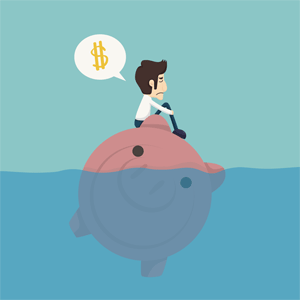Budgeting strategies for government stimulus payments
An estimated 65 million stimulus payments will be made to households over the coming weeks as part of the US federal government CARES Act. But a good portion of those will arrive much later than expected, potentially even too late for some families in dire straits today.
For others, these checks will be better suited for acute emergencies rather than meeting ends meet for a prolonged period of time.
To help people manage the likely trade-offs they’ll be forced to meet, we’ve offered some suggestions for how households in one of three general situations could maximise the impact of their payments.

Suggestions for how households in one of three general situations could maximise the impact of their payments
No emergency savings, no income
Those who have lost jobs or have drastically reduced income without any type of safety net will have to spend funds on immediate needs. The key is prioritisation, determining which bills are flexible, and identifying other areas of support.
- Two-week horizon. Research shows that scarcity can create tunnel vision and make it difficult to judge the pros and cons of different options. People must force themselves to take a wide view prioritisation and list out needs using a two-week horizon. Anything that absolutely must be paid within those two weeks gets the money first – groceries, medicines, gas to make it to work, etc.
- Flexible payments. Leftover funds can be assigned to priority bills outside that two-week horizon. Many states are prohibiting utility shut offs and evictions, potentially providing flexibility. Those bills will be due at some point, but there could be additional programs or extended payment terms available.
- Find support. Support your list of bills both inside and outside the two-week prioritisation with additional funds to try and create slack. Consider all local, state, and national assistance programs including unemployment, utility assistance, or other government programs that have been expanded through the CARES Act. Gig workers and small business owners can also tap newly available SBA loan programs. And be sure to explore philanthropic efforts such as a local United Way.
Partial savings, partial income
These households have a little more financial flexibility. While funds may be needed, they have enough of a cushion or income to offer more choices and options.
- Create rules. When trying to manage a monthly paycheck or government benefits like SNAP, it’s hard to manage spending over a longer period of time. Even with slack in their budgets, people must plan ahead and set up rules to guide their spending week-by-week.
- Start saving. Depositing the stimulus funds into a checking account makes it challenging to maximise funds. Use a savings account to “hide” a portion of the funds not for immediate use. Research has found this partitioning of available resources into multiple accounts can significantly slow spending and increase savings. If you have to open a savings account to do this, make sure it has zero fees. You can look for a local Community Development Financial Institution or consider the handful of digital options with no fees.
Solid savings, fully employed
Some people have remained in good financial standing or do not need the funds as much as others. While it’s possible for them to pay it forward, there are also ways to insulate themselves against future financial shocks.
- Pay it forward. There are multiple ways that individuals who do not need a check can use that money to improve the lives of those around them and the communities they live in. Many charities and non-profits serving those affected by the pandemic rely on donations. People can buy gift cards or increase spending at their local businesses, many of which are struggling to keep their doors open.
- Build an “Emergency Savings” cushion. Even before the COVID-19 pandemic, a majority of households were unprepared for an unexpected expense. One reason people do not save enough is because they underestimate how often unexpected expenses arise. While these individuals may be currently unaffected, having a cushion in case of emergency is an important step to maintaining that financial well-being.
- Plan now. However these households decide to use their stimulus funds, the key is to decide now before payments arrive. Research has consistently shown that people are much better at making decisions for the future rather than for the present. People can go even further by setting up a commitment device – like signing the a public pledge or sharing intentions with a friend – to ensure they follow-through on their intentions.











































